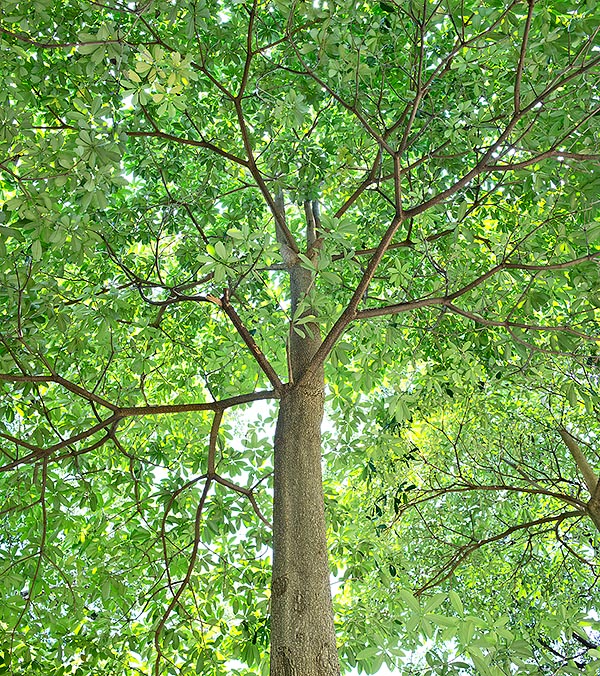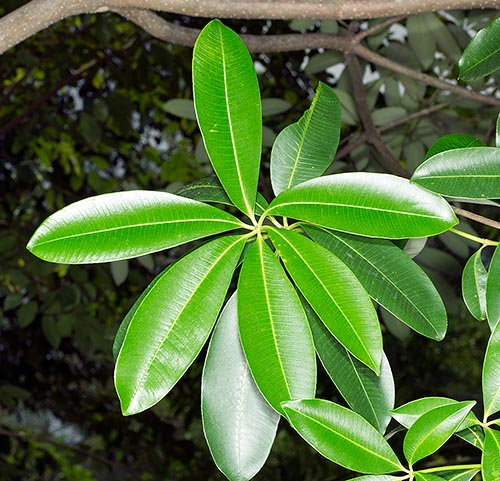Family : Apocynaceae

Text © Pietro Puccio

English translation by Mario Beltramini

Magic tree in India, Alstonia scholaris has vast diffusion in tropical and subtropical Asia up to beyond Australia. Can be 40 m tall with even more than 1 m broad cylindrical trunk © Giuseppe Mazza
The species is native to Andaman Islands, Arunachal Pradesh, Assam, Australia (Northern Territory, Queensland, Western Australia), Bangladesh, Bhutan, Bismarck Archipelago, Borneo, Cambodia, China (Anhui, Chongqing, Fujian, Guangdong, Guangxi, Guizhou, Henan, Hong Kong, Hubei, Hunan, Jiangsu, Jiangxi, Kin-Men, Macao, Ma-tsu-Pai-chúan, Shanghai, Sichuan, Yunnan and Zhejiang), Darjeeling, Himachal Pradesh, India, Jammu-Kashmir, Java, Laccadive Islands, Laos, Lesser Sunda Islands, Moluccas, Myanmar, Nepal, New Guinea, Nicobar Islands, Pakistan, Peninsular Malaysia, Philippines, Sikkim, Salomon Islands, Sri Lanka, Sulawesi, Sumatra, Thailand, Uttaranchal and Vietnam where it grows in the humid forests, often close to rivers, up to about 1000 m of altitude.
The genus is honoured to the Scotish physician and botanist Charles Alston (1685-1760); the specific name is the Latin adjective “scholaris” = of the school, with reference to the old employment of the wood for fabricating the tablets used by the pupils for writing.
Common names: blackboardtree, deviltree, dita bark, dita tree, milky-pine, scholar tree, white cheesewood, white-pine (English); chatium (Bengali); lettok (Burmese); tang jiao shu, xiang pi mu (Chinese); chitaban, shaitan ka jat (Hindi); maddale (Kannada); pulai (Malay); chhatiwan (Nepali); saptaparna (Sanskrit); palai (Tamil); thia, tinpet phru (Thai); Teufelsbaum (German).
The Alstonia scholaris (L.) R. Br. (1810) is an evergreen tree with thick canopy, 20-40 m tall, with cylindrical trunk, of up to 1,2 m of diameter, provided at the base with tabular roots (flattened roots similar to buttresses that contribute in sustaining the big trees), and greyish bark; from the wounds exudes an abundant milky sap.
The leaves, on a 1-2 cm long petiole and arranged in verticils of 4-9, are simple, oblong-ovate to oblong-spathulate with entire margin and obtuse apex, coriaceous, 8-22 cm long and 3-8 cm broad, dark green and glossy above, pale green below. The inflorescences, at the axil of the terminal leaves on a 3-7 cm long peduncle, are pubescent cymes, compact, with several white greenish flowers, fragrant, with about 2 mm long calyx, cylindrical corolline tube, 0,5-1 cm long, and 5 ovate lobes 2-5 mm long.

The leaves, arranged in verticils, reach the 22 cm. All parts of the plant are toxic. Traditional therapeutic virtues under pharmacological review © Giuseppe Mazza
It propagates by seed, interred just under the surface, in organic draining loam maintained humid at the temperature of 24-26 °C, with germination times going from 2 weeks to 3 months, and by cutting.
Tree with rather fast growth with very decorative foliage for parks, gardens and road trees at the tropics and subtropics, requires an exposition in full sun and is not particular about the soil, growing in the wild in an ample variety of grounds, can bear when adult short periods of drought.
The wood, light and little resistant to the atmospheric agents, is utilized for inner parts, handicrafts, in the fabrication of plywood and in the production of the paper.
Due to the high number of alkaloids present, all parts of the plant are toxic. The leaves and the bark, of bitter taste, are utilized since remote times in the popular medicine, in particular for the diseases of the respiratory system and as treatment for the diarrhoea and dysentery, on the effectiveness of which till now (2015) there is not a complete agreement, but are under way numerous laboratory studies on the pharmacological effects of the bioactive compounds present.
Inside the European Community the presence of its bark is not allowed in the dietary supplements.
The tree has also magical and religious meanings; for some Indian populations inside the tree lives an evil spirit that can get possession of the persons passing by and for this reason it is carefully avoided.
Synonyms: Echites scholaris L. (1767).
→ To appreciate the biodiversity within the APOCYNACEAE family please click here.
